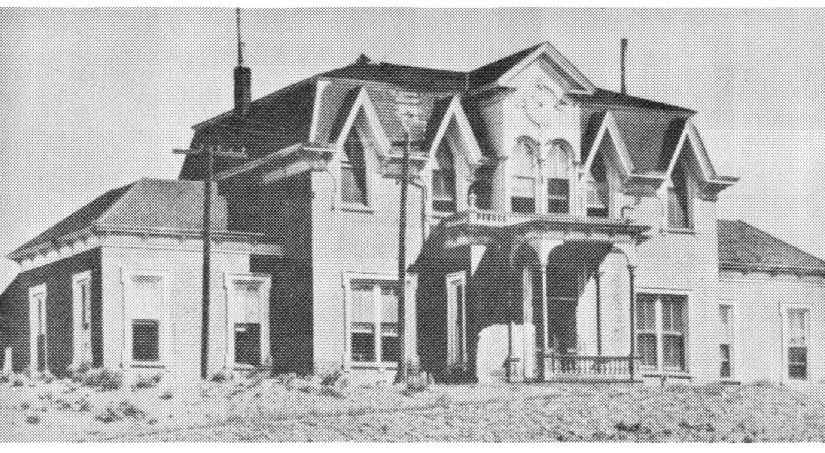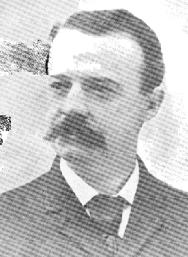HOWARD
HICKSON'S HISTORIES
[Index]
Hardly a High School
University of Nevada, Elko (1874-1885)
Elko High School's "Old Gymnasium" was recently remodeled.
It stands on the site of the first University of Nevada. Here's the story:
There was a bustling brashness about young
Elko in 1872. It was a railroad town, supply center for area ranches, and
freight depot for the mining camps scattered in the hills of northeast
Nevada. The community of about one thousand people had come a long way
in three short years when Central Pacific Railroad crews laid track across
the sagebrush flats next to the Humboldt River.
Miners, wranglers, sheepherders, and
railroad men rubbed elbows in the town's 45 saloons. Ranch wives filled
wagons with long lists of staples on their monthly trip to town. Mining
equipment and materials stacked on the docks of the three railroad warehouses
waited for freight wagons. Times were very good.
An advertisement appeared in the Elko
Independent asking for bids and proposals to be the site of the state
university. The bids were due in ten days and Elkoans wanted the school.
So did every other water stop and tent town in the state. Let's not beat
around the bush. State institutions were spoils, distributed according
to political influence. At the moment, Elko had a great deal of power through
Lewis R. "Broadhorns" Bradley, a hometown boy who happened to be governor
of Nevada.
On March 1, 1872, university regents opened
proposals from Elko, Genoa, Carson City, Washoe City, Washoe Valley, and
Reno. Elko's most verbal opponent, Reno, bid $10,000. Elkoans smirked a
bit when their overture of $28,000 topped the field. The regents decided
they couldn't make the decision and dumped the matter into the legislative
chambers for the 1873 session. After attempts to substitute Reno and Winemucca
in the bill, Elko won by a large majority in both houses. A preparatory
school would be established making the coveted prize only a state supported
high school. The battle, more small town rivalry than zeal for education,
was over - for awhile.
A site on a hill west of town was selected
by the local committee and a well dug. The well did not produce any water.
Time was very short, only ten months to build a university building, when
the group decided the campus would to be on 21 acres just north of town.
The area is now in the middle of Elko.
The university campus was bordered by
Court, Ninth, Oak (not a through street) and Twelfth streets. The new building
would rise from the sagebrush in the northwest corner of the campus, where
the old gymnasium at Elko High Schools now stands (corner of Ninth Street
and College Avenue).
The contractor had to begin immediately
since the deadline for completion of the $5,000 building was February 15,
1874. They didn't fiddle around in those days.
The main building was 30 by 50 feet,
the two wings each 20 by 20 feet. Work was completed a month ahead of time.
Meanwhile, there was futile plea after futile plea in the newspaper for
people to contribute to the building fund - without a great deal of success.
Here's the arithmetic: The original cost was estimated at $5,000; before
the smoke cleared, those costs had soared to $15,000. So, what's new in
the construction world? Fund raisers had gathered $3,000. The committee
went to the county for bailing out.
Commissioners authorized a $12,000 bond. The
university building was handed over to the state free and clear but Elko
County was saddled with the debt for years. But, the first university in
the state stood on a hill overlooking Elko. It was a great day!

First University of Nevada Building in Elko. It was on the corner
of Ninth Street and College Avenue where the "Old Gymnasium"
on the Elko High School campus now stands. Photograph
from the Illustrated History of the University
of Nevada, 1924, by Sam Doten
On February 23, 1874, the upstairs assembly
hall was cleaned and the floors waxed in readiness of the Grand University
Ball to be held that evening. What an evening it was when 65 couples, paying
$6 each, came to the festivities in 33 degree below zero weather. In today's
coin of the realm, the people paid eighty to ninety dollars for their ticket.
It must have been a snobbish affair with only the wealthy attending.
David Robert Sessions, a Princeton graduate,
was appointed to head the new school. For four years he conducted a one-man
school teaching a list of subjects that might overwhelm a modern high school
instructor.
 Sessions enrolled
the first class. In his words, "I set about to gather any pupils that were
available. I made no formal examination for admission but selected a class,
boys and girls, more with reference to what they might learn as to what
they knew. Two or three might have stood a fair entrance examination in
a high school. The others I took on faith. All told, there were seven." Sessions enrolled
the first class. In his words, "I set about to gather any pupils that were
available. I made no formal examination for admission but selected a class,
boys and girls, more with reference to what they might learn as to what
they knew. Two or three might have stood a fair entrance examination in
a high school. The others I took on faith. All told, there were seven."
Members of the first student body in
a building built and furnished for one hundred were: Margaret Yeates (Keyser),
Jessie Yeates (Hesson), Frank Rodgers, Allen Penrod, James B. Gallagher,
Sarah Gillan (Muller), and Charles L. Rood. All were from Elko except Gillan,
from Lamoille, and Penrod, from Island Mountain Mining District. Classes
began October 12, 1874. All the students earned passing grades that first
year.
The next year classes began September
24, 1875, with most of the former students and few new ones showing up
for entrance exams. The optimistic editor of the Independent claimed
the university had 16 scholars.
Various legislators, mostly those from
the towns still trying to get the school located in their community, continually
tried to cut finances or stop the money altogether over the next ten years.
Somehow, though, funding, albeit miserly, was provided by the state.
A dormitory was constructed at the corner
of Ninth and Court streets. When it was finished in mid-January, Superintendent
Sessions and his wife promptly moved in.

University of Nevada, Elko, dormitory at the corner of
Ninth and Court streets. Drawing from History of Nevada,
1881,
by Thompson and West.
Even with sparse enrollment and money, the
first athletic team was fielded in March, 1877. James B. Gallagher, captain
of the school's baseball team, issued a challenge to any ten-man team to
play for the championship of Elko.
The collegians played a three and one half
hour game against a town team calling themselve the Royal Exclusives. The
red and white clad youngsters, "looking like cheerfully animated barber
poles," slugged out a 31 to 22 win.
When Sessions was elected State Superintendent
of Public Instruction he left Elko and the still fledgling school he started
still suffering from drastically low enrollment. W.C. Dovey was appointed
to replace him.
Newspapers around the state continually complained
that the institution was a failure and should never had been given to Elko.
It was too far away from the population center. Study at the university
cost next to nothing. Tuition and lodging were free. Board was only $30
monthly but students from the western side of the state had to travel upward
to three hundred miles on dirt roads or the railroad to get here. With
opposition from other towns, newspapers, and legislators the school struggled
on. The largest enrollment reached 34 students - in its last year in Elko.
Every session of the legislature was a battle of one kind or another -
cut funding or move the school - but somehow the University stayed in Elko
until 1885. It survived for 11 years.
In the 1885 session of the legislature a bill
was introduced to relocate the campus to Carson City. It failed by one
vote. On the last day it was decided to move the University to Reno. Elko
County would be paid $20,000. The measure passed the Assembly 30 to 9 and
the Senate 12 to 6. That was it. On July 10, 1885, the University of Nevada
in Elko closed its doors, the victim of jealousies and politics.
Epilog
After the students left, the building continued
in public service. It was converted into the county hospital until demolished
to make room for a gymnasium for Elko High School.
The dormitory was sold and moved north on
Ninth Street to the next lot. It became a boarding house and then met the
same fate as the main building. It was torn down.
Other than a few memories, all that remains
of the first University of Nevada is a street called College Avenue. It
runs in front of the site - put in and named after the school left town.
In 1967, with funds collected locally, an
ambitious group of Elko people started the first community college in the
state. First called Elko Community College, its name was changed to Northern
Nevada Community College, and now the institution, located on Elm Street
with an attractive campus, is Great Basin College.
Howard Hickson
January 7, 2001
Photograph credit: David S. Sessions, first principal of the
University of Nevada, from Nevada State University, 1874-1904, edited
by J.E. Church, Jr.
Source: This vignette is condensed from an article I researched
and wrote titled "Hardly a High School," published in the Northeastern
Nevada Historical Quarterly, Winter 1974.
©Copyright 2001 by Howard Hickson. Anyone is
welcome to quote or use any portion or all of this article but proper credit
must be given to the author.
[Back to Hickson's Histories Index]
|
